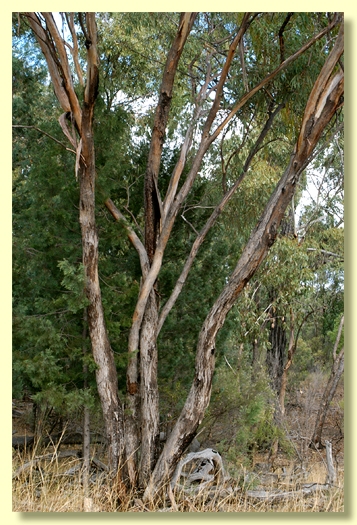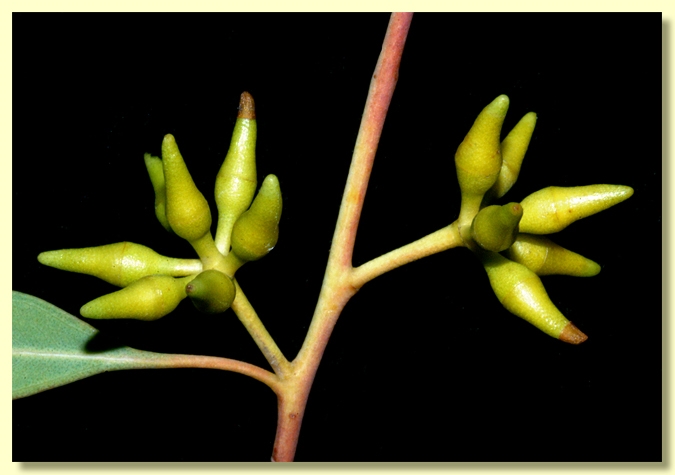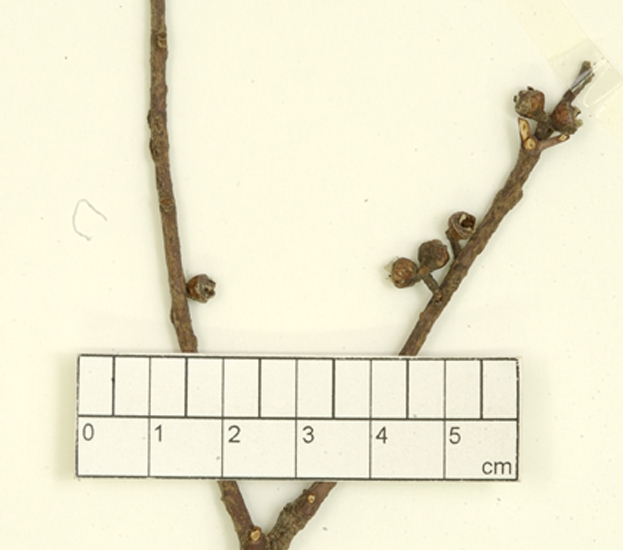Eucalyptus | Symphyomyrtus | Exsertaria | Erythroxylon
Euclid - Online edition
Eucalyptus terrica
Tree to 10 m tall. Forming a lignotuber.
Bark rough, thin, fibrous, grey over brown to orange, normally only on the trunk and larger branches, sometimes on the lower trunk only. Smooth bark on upper trunk or branches grey to brown to white over greenish-grey to yellowish-grey to yellowish-brown to orange-yellow.
Juvenile growth (coppice or field seedlings to 50 cm): stem square or rounded in cross-section; sometimes glaucous, juvenile leaves shortly petiolate, alternate, narrowly lanceolate, 6–14 cm long, 1–2.5 cm wide, dull, green to grey-green to sometimes slightly glaucous.
Adult leaves alternate, petiole 0.7–2 cm long; blade narrowly lanceolate to lanceolate, (5)7.5–13 cm long, 0.9–1.7(2) cm wide, base tapering to petiole, concolorous, dull, grey-green to green, side-veins acute, less than 45° to midrib, moderately reticulate, intramarginal vein parallel to the margin, oil glands numerous and island.
Inflorescence axillary unbranched, peduncles 0.3–1.2 cm long, buds 7, pedicellate (pedicels 0.1–0.3 cm long). Mature buds ovoid (0.6–0.8 cm long, 0.3–0.4 cm wide), yellow or creamy, smooth, scar present, operculum conical to horn-shaped (0.4–0.6 cm long), stamens erect to irregularly flexed, anthers cuboid to oblong, versatile, dorsifixed, dehiscing by longitudinal slits (non-confluent), style long, stigma tapered, locules 3 or 4, the placentae each with 6–8 vertical ovule rows. Flowers white.
Fruit pedicellate (pedicels 0.1–0.3 cm long), hemispherical or rarely slightly campanulate, 0.2–0.4 cm long, 0.4–0.6 cm wide, disc raised or level, raised disc convex to oblique, valves 3 or 4, strongly exserted.
Seeds dark brown, 0.9–1 mm long, pyramidal or ± cuboid, dorsal surface pitted, seed edge toothed, hilum terminal.
Cultivated seedlings (measured at ca node 10): cotyledons reniform to oblong or ± bilobed; stems square in cross-section, glaucous or non-glaucous; leaves always petiolate, opposite for the first 3 to 7 nodes then becoming alternate, narrowly lanceolate to lanceolate, 5.5–13 cm long, 1–2 cm wide, base tapering, apex pointed, dull, grey-green to green.
Flowering time unknown.
A small tree from the Warwick–Inglewood area of south-east Queensland, on stony ridges. It is characterised by its relatively thin, brown to orange, rough bark over the trunk, sometimes extending to the larger branches, its narrow adult leaves, small buds and fruits, and its narrowly lanceolate juvenile leaves.
Eucalyptus terrica belongs to the group of red gums (Eucalyptus subgenus Symphyomyrtus section Exsertaria series Erythroxylon ) which is distinguished by having buds with the stamens mostly erect, fruit where the disc is united to the ovary roof, and by the black, toothed, cuboid to pyramidal single-coated seed. Fifteen species belong to this group: E. amplifolia, E. blakelyi, E. infera, E. kabiana, E. tereticornis, E. chloroclada, E. dealbata, E. dwyeri, E. flindersii, E. gillenii, E. glaucina, E. nandewarica, E. nudicaulis, E. terrica and E. vicina.
Within this group, E. terrica is closely related to E. chloroclada, a species of sandy sites a little further inland, because both species usually have thin brown to orange-brown rough bark on the lower trunk, have similar buds with the operculum never more than twice the length of the hypanthium (base of bud), and have fruit with a raised or level disc. They are separated by their juvenile leaves which are ovate in E. chloroclada and lanceolate to narrowly lanceolate in E. terrica. The thin rough brown to orange rough bark separates E. terrica from all other members of this group . However, on rare occasions, some individuals of E. dealbata in south-east Queensland and northern New South Wales have a small amount of rough bark on the lower trunk. E. dealbata can be easily separated from E. terrica by its glaucous diamond-shaped buds and broadly ovate-orbicular juvenile leaves.
Within its area of occurrence, E. terrica may be confused with another closely related rough-barked red gum, E. exserta. Both can be separated by the rough bark, which is usually thicker, harder and extends right to the small branches in E. exserta, but thin and only to the large branches in E. terrica, and by the juvenile leaves which are normally linear to narrowly lanceolate in E. exserta (0.3–1.3 cm wide) but lanceolate to narrowly lanceolate in E. terrica (1–2.5 cm wide). The disc of the fruit is steeply raised in E. exserta whilst flat or only slightly raised to convex in E. terrica.
MORE ABOUT RED GUMS AND OTHER ASSOCIATED GROUPS
Eucalyptus terrica: referring to Terrica Station, Queensland, where the type specimen was collected.

















